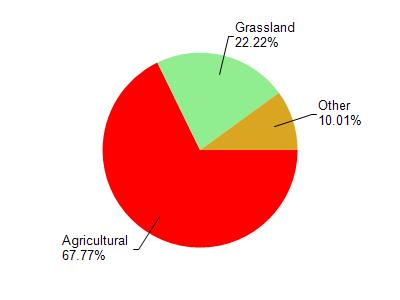Green
No
No
No
Fish and Aquatic Life
Overview
This stream rises in Green County near the state line and flows into Richland Creek in Illinois. Hilsenhoff Biotic Index (HBI) monitoring from 1988 indicated that the stream had good water quality. The ozark minnow and slender madtom have been found in this stream. The stream has not been revisited recently to determine the contemporary status.
Date 2002
Author Aquatic Biologist
Overview
East Branch Richland Creek, located in southeast Crawford County, flows for 2.5 miles in a southwesterly direction before reaching Richland Creek just south of Plugtown. This stream has a gradient of 61 feet per mile and drains steep forested hillsides with some agriculture found in the valleys. East Branch Richland Creek is not a classified trout stream.
The most recent biological survey, conducted in July 1989, documented brown trout and numerous minnow species. East Branch Richland Creek was last stocked in the fall of 1989 with brook trout. A fish and habitat survey of East Branch Richland Creek should be conducted to determine the success of the brook trout stocking and a possible change in stream classification. Access to this stream is from three road crossings.
Date 2001
Author Aquatic Biologist
Overview
This stream rises in Green County near the state line and flows into Richland Creek in Illinois. Hilsenhoff Biotic Index (HBI) monitoring from 1988 indicated that the stream had good water quality. The ozark minnow and slender madtom have been found in this stream. The stream has not been revisited recently to determine the contemporary status.
Date 1988
Author Aquatic Biologist
Historical Description
Bush, D.M., R. Cornelius, D. Engle, and C.L. Brynildson. 1980. Lake and Stream Classification Project. Surface Water Resources of Green County, 2nd Edition. Wisconsin Department of Natural Resources, Madison, Wisconsin.
Beginning near the ~Jisconsin-Illinois border. this small warmwater stream flows southwest into Illinois and joins Richland Creek. It experiences moderate bank erosion as it flows mainly through pasture and hardwood forest. Silt. muck and gravel are the primary bottom types. but bedrqck. boulder and rubble are also pr~sent. The water is clear.
Richland Cree~~ast Branch has a c!-iverse forage species fishery, dominated by the central stonero.ller. In addition, the endangered Ozark minnow and the rare slender madtom are both found in the stream. ~Iildlife values are limited to muskrats, and public access consists of three town road crossings.
Fish Species: Central stoneroller, stoneroller x southern redbelly dace hybrid, Olark minnow, hornyhead chub common shiner, common shiner x southern redbelly dace hybrid, bigmouth shiner, suckermouth minnow, southern redbelly dace, bluntnose minnow, fathead minnow, creek chub, common shiner x hornyhead chub hybrid, white sucker, slender madtom, stonecat, brook stickleback, green sunfish, fantail darter, Johnny darter.
Surface Acres = 1.8, Length = 3.0 Miles, Gradient = 25 ft./mi., Base Oischarge = 4.4 cu. ft./sec.
Date 1980
Author Surface Water Inventory Of Wisconsin
Condition
Wisconsin has over 84,000 miles of streams, 15,000 lakes and milllions of acres of wetlands. Assessing the condition of this vast amount of water is challenging. The state's water monitoring program uses a media-based, cross-program approach to analyze water condition. An updated monitoring strategy (2015-2020) is now available. Compliance with Clean Water Act fishable, swimmable standards are located in the Executive Summary of Water Condition in 2018. See also the 'monitoring and projects' tab.
Reports
Management Goals
Wisconsin's Water Quality Standards provide qualitative and quantitative goals for waters that are protective of Fishable, Swimmable conditions [Learn more]. Waters that do not meet water quality standards are considered impaired and restoration actions are planned and carried out until the water is once again fishable and swimmable
Management goals can include creation or implementation of a Total Maximum Daily Load analysis, a Nine Key Element Plan, or other restoration work, education and outreach and more. If specific recommendations exist for this water, they will be displayed below online.
Monitoring
Monitoring the condition of a river, stream, or lake includes gathering physical, chemical, biological, and habitat data. Comprehensive studies often gather all these parameters in great detail, while lighter assessment events will involve sampling physical, chemical and biological data such as macroinvertebrates. Aquatic macroinvertebrates and fish communities integrate watershed or catchment condition, providing great insight into overall ecosystem health. Chemical and habitat parameters tell researchers more about human induced problems including contaminated runoff, point source dischargers, or habitat issues that foster or limit the potential of aquatic communities to thrive in a given area. Wisconsin's Water Monitoring Strategy was recenty updated.
Grants and Management Projects
| Project Name (Click for Details) | Year Started |
|---|
|
|
Monitoring Projects
| WBIC | Official Waterbody Name | Station ID | Station Name | Earliest Fieldwork Date | Latest Fieldwork Date | View Station | View Data |
|---|
| 889500 | East Branch Richland Creek | 10016857 | East Br. Richland Cr. - Freeport Rd. | 10/22/1981 | 10/28/1987 | Map | Data |
| 889500 | East Branch Richland Creek | 10012763 | East Branch Richland Creek -(atFive Corner Rd) | 10/22/1981 | 1/1/2015 | Map | Data |
|

Watershed Characteristics
East Branch Richland Creek is located in the Honey and Richland Creeks watershed which is 80.09 mi². Land use in the watershed is primarily agricultural (67.70%), grassland (22.20%) and a mix of suburban (4.40%) and other uses (5.60%). This watershed has 195.33 stream miles, 16.47 lake acres and 117.89 wetland acres.
Nonpoint Source Characteristics
This watershed is ranked Medium for runoff impacts on streams, Not Ranked for runoff impacts on lakes and High for runoff impacts on groundwater and therefore has an overall rank of High. This value can be used in ranking the watershed or individual waterbodies for grant funding under state and county programs.However, all waters are affected by diffuse pollutant sources regardless of initial water quality. Applications for specific runoff projects under state or county grant programs may be pursued. For more information, go to surface water program grants.